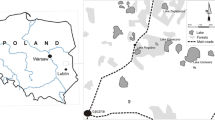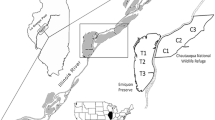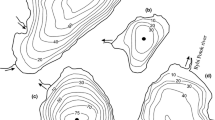Abstract
A 7 year study (1992–1998) of littoral microcrustaceans (Cladocera and Copepoda) in the watercourse of the River Rore, South Norway, illustrates that qualitative data on cladocerans and copepods are well suited to indicate the recovery of lakes following liming. Eight limed, two acid and two circum neutral reference lakes, were sampled twice a year (June/July and September/October). In the limed lakes, species associated with neutral lakes have become more common, whereas apparently acid-tolerant species have become rarer. In Lake Rore and Lake Syndle, the two largest limed lakes which exhibited a gradual increase in pH, the changes in species composition indicated that these lakes were about to recover. Species composition in Lake Røynelandsvatn, which has reacidified after liming, first reflected improved water quality, then reverted to dominance by acid-tolerant species. In the remaining lakes, the species composition reflects a fauna which has recovered compared with the preliming situation. There is strong evidence, however, that temporary fluctuations in pH have a negative influence on the speed of recovery, confirming the importance of keeping pH stable.
Similar content being viewed by others
References
Arvola, L., K. Salonen, I. Bergström, A. Heinänen & A. Ojala, A., 1986. Effects of experimental acidification on phyto-, bacterioand zooplankton in enclosures of a highly humic lake. Int. Rev. ges. Hydrobiol. 71: 737–758.
Baker, J. P., D. P. Bernard, S. W. Christensen, M. J. Sale, J. Freda, K. Heltcher, D. Marmorek, L. Rowe, P. Scanlon, G. Suter, W. Warren-Hicks & W. Welbourn, 1990. Biological Effects of Changes in Surface Water Acid-Base Chemistry. NAPAP Report 13. In National Acid Precipitation Assessment Program, Acidic Deposition: State of Science and Technology, Volume II, 1990.
Brett, M. T., 1989. Zooplankton communities and acification processes (A review). Wat. Air Soil Pollut. 44: 387–414.
Carpenter, S. R., T. M. Frost, D. Heisy & T. K. Kratz, 1989. Randomized intervention analysis and the interpretation of wholeecosystem experiments. Ecology 70: 1142–1152.
Degerman, E., L. Henrikson, J. Herrmann & P. Nyberg, 1995. The effects of liming on aquatic fauna. In Henrikson, L. & Y. W. Brodin (eds), Liming of Acidified Surface Waters. A Swedish Synthesis. Springer-Verlag, Berlin: 221–282.
Drabløs, D. & A. Tollan, 1980. Proceedings from the Internationale Conference on ecological Impact on Acid Precipitation, Sandefjord, Norway: 383 pp.
Evans, R. A., 1989. Response of limnetic insect populations of two acidic, fishless lakes to liming and brook trout (Salvelinus fontinalis). Can. J. Fish. aquat. Sci. 46: 342–351.
Halvorsen, G., S. E. Sloreid & B. Walseng, 1996. Dokka-deltaet – ferskvannsbiologiske konsekvenser av kraftutbyggingen i Dokkavassdraget. NINA Oppdragsmelding 437: 1–101.
Hann, B. J. & M. A. Turner, 2000. Littoral microcrustacea in Lake 302S in the experimental lakes area of Canada: acidification and recovery. Freshwat. Biol. 43: 133–146.
Hasselrot, B., B. I. Andersson & H. Hultberg, 1984. Ecosystem shifts and reintroduction of arctic char (Salvelinus salvelinus (L.)) after liming of a strongly acidified lake in Southwestern Sweden. Rep. Inst. Freshwat. Res., Drottningholm 61: 78–92.
Havens, K. E., 1991. Littoral zooplankton responses to acid and aluminum stress during short-term laboratory bioassays. Envir. Pollut. 73: 71–84.
Havens, K. E. & J. DeCosta, 1987. Freshwater zooplankton community succession during experimental acidification. Arch. Hydrobiol. 111: 37–65.
Havens, K. E. & T. Hanazato, 1993. Zooplankton community responses to chemical stressors: A comparison of results from acidification and pesticide contamination research. Envir. Pollut. 82: 277–288.
Henrikson, L. & Y. W. Brodin, 1995. Liming of acidified surface waters. A Swedish synthesis. Springer-Verlag, Berlin: 458 pp.
Henrikson, L., H. G. Oscarson & J. A. E. Stenson, 1984. Development of the crustacean zooplankton community after lime treatment of the fishless Lake Gårdsjön, Sweden. Rep. Inst. Freshwat. Res., Drottningholm 61: 104–114.
Hill, M. O., 1979. DECORANA – A Fortran program for detrended correspondence analysis and reciprocal avaraging. Cornell University, Ithaca, New York: 52 pp.
Hill, M. O. & H. G. Gauch, 1980. Detrended correspondence analysis: an improved ordination technique. Vegetatio 42: 47–58.
Huitfeldt-Kaas, H., 1906. Planktonundersøgelser i norske vande. Nationaltrykkeriet, Christiania: 199 pp.
Hultberg, H. & I. B. Andersson, 1982. Liming of acidified lakes: induced long-term changes. Wat. Air Soil Pollut. 18: 311–331.
Keller, W., L. A. Molot, R.W. Griffiths & N. D. Yan, 1990. Changes in the zoobenthos community of acidified Bowland Lake after whole lake neutralization and lake trout (Salvelinus namaycush) reintroduction. Can. J. Fish. aquat. Sci. 47: 440–445.
Keller, W., N. D. Yan, T. Hovell, L. A. Molot & W. D. Taylor, 1992. Changes in zooplankton during the experimental neutralization and early reacidification of Bowland Lake near Sudbury, Ontario. Can. J. Fish. aquat. Sci. 49(Suppl. 1): 52–62.
Krause-Dellin, D. & C. Steinberg, 1986. Cladoceran remains as indicators of lake acidification. Hydrobiologia 143: 129–134.
Kroglund, F., T. Hesthagen, A. Hindar, G. G. Raddum, M. Staurnes, D. Gausen & S. Sandøy, 1994. Sur nedbør i Norge. Status, utviklingstendenser og tiltak. DN – Utredning 1994-10: 98 pp.
Locke, A., 1991. Zooplankton responses to acidification: a review of laboratory bioassays. Wat. Air Soil Pollut. 60: 135–148.
Locke, A., W. G. Sprules, W. Keller & J. R. Pitblado 1994. Zooplankton communities and water chemistry of Sudbury area lakes: changes related to pH recovery. Can. J. Fish. aquat. Sci. 51: 151–160.
Lotter, A. F., H. J. B. Birks, W. Hofmann & A. Marchetto, 1997. Modern diatom, cladocera, chironomid and chrysophyte cyst assemblages as quantitative indicators for the the reconstruction of past enviromental condition in the Alps. I. Climate. J. Palaeolimnol. 18: 395–420.
Morling, G. & B. Pejler, 1990. Acidification and zooplankton development in some West-Swedish Lakes 1966–1983. Limnologica (Berlin) 20: 307–318.
Muniz, I. P., 1991. Freshwater acidification: its effects on species and communities of freshwater microbes, plants and animals. Pros. roy. Soc. Edinburgh 97B: 227–254.
Nilssen, J. P., 1984. An ecological jig-saw puzzle: reconstructing aquatic biogeography and pH in acidified regions. Rep. Inst. Freshwat. Res., Drottningholm 61: 138–147.
Orendt, C., 1998. Macroinvertebrates and diatoms as indicators of acidification in forest spring brooks in a region pf eastern Germany (Leipzig-Halle-Bitterfield) highly impacted by industrial activities. Arch. Hydrobiol. 143: 435–467.
Paterson, M., 1994. Paleolimnological reconstruction of resent changes in assemblages of Cladocera from acidified lakes in the Adirondack Mountains (New York). Freshwat. Biol. 11: 189–200.
Potts, W. T. W. & G. Fryer, 1979. The effects of pH and salt content on sodium balance in Daphnia magna and Acantholeberis curvirostris (Crustacea: Cladocera). J. comp. Physiol. 129: 289–294.
Raddum, G. G. & A. Fjellheim, 1994. Invertebrate community changes caused by reduced acidification. In Steinberg, C. E. W. & R. F. Wright (eds), Acidification of Freshwater Ecosystems: Implications for the Future. John Wiley and Sons Ltd., Chichester: 345–354.
Raddum, G. G., A. Fjellheim & T. Hesthagen, 1988. Monitoring of acidification through the use of aquatic organism. Verh. int. Ver. Limnol. 23: 2291–2297.
Rudd, J. W. M., C. A. Kelly, D. W. Schindler & M. A. Turner, 1990. A comparison of the acidification effiencies of nitric and sulfuric acids by two whole-lake addition experiments. Limnol. Oceanogr. 35: 663–679.
Schartau, A. K., A. Hobæk, B. Faafeng, G. Halvorsen, J. W. Løvik, T. Nøst, A. L. Solheim & B. Walseng, 1997. Diversity of zooplankton and littoral crustaceans in freshwater – natural gradients, and effects of pollution, encroachments and introductions. NINA temahefte 14, NIVA lnr 3768-97: 58 pp.
Schartau, A. K. & B. Walseng, in press. Correlation between crustacean community and enviromental variables in Killarney, Sudbury. Will be presented on “6th International Conference on Acidic Deposition in Japan, December 2000”.
Schindler, D. W., 1988. Effects of acid rain on freshwater ecosystems. Science 239: 149–157.
Schindler, D. W., T. M. Frost, K. H. Mills, P. S. S. Chang, I. J. Davies, D. L. Findlay, D. F. Malley, J. A. Shearer, M. A. Turner, P. J. Garrison, C. J. Watras, K. E. Webster, J.M. Gunn, P. L. Brezonik & W. A. Swenson, 1991. Comparisons between experimentally and atmospherically acidified lakes during stress and recovery. Pros. r. Soc. Edinburgh 97B: 193–226.
Siegfried, C. A. & J. W. Sutherland, 1992. Zooplankton communities of Adirondack lakes: changes in community structure associated with acidification. Freshwat. Biol. 7(2): 97–112.
Stenson, J. A. E. & J. E. Svensson, 1994. Manipulation of planktivore fauna and development of crustacean zooplankton after restoration of the acidified Lake Gårdsjön. Arch. Hydrobiol. 131: 1–23.
Svensson, J.-E., L. Henrikson, S. Larsson & A. Wilander, 1995. Liming strategies and effects: The lake Gårdsjön case study. In Henrikson, L. & Y.W. Brodin (eds), Liming of Acidified Surface Waters. A Swedish Synthesis. Springer-Verlag, Berlin: 309–523.
Ter Braak, C. J. F., 1987. CANOCO – a FORTRAN program for canonical community ordination by (partial) (detrended) (canonical) correspondance analysis, principal components analysis and redundancy analysis (Version 2.1). TNO Institute of Applied Computer Science: 95 pp.
Ter Braak, C. J. F., 1990. Update notes: CANOCO version 3.10. Agriculture Math. Group, Wageningen: 35 pp.
Walseng, B., 1994. Alona spp. in Norway: Distribution and ecology. Verh. int. Ver. Limnol. 25: 2358–2359. 63 pp.
Walseng, B., 1998. Occurence of Eucyclops species in acid and limed water. Verh. int. Ver. Limnol. 26: 2007–2012.
Walseng, B. & G. Halvorsen, 1996a. Cladocera. In Aagaard, K. & D. Dolmen (eds), A Catalogue of the Known Freshwater Fauna (in Norwegian). Tapir, Trondheim: 95–99.
Walseng, B. & G. Halvorsen, 1996b. Copepoda. In Aagaard, K. & D. Dolmen (eds), A Catalogue of the Known Freshwater Fauna (in Norwegian). Tapir, Trondheim: 103–107.
Walseng, B., G. G. Raddum & F. Kroglund, 1995. Kalking i Norge. Invertebrater. DN-utredning 1995–6: 63 pp.
Weider, L. J., W. Lampert, M. Wessels, J. K. Colbourne & P. Limburgh, 1997. Long-term genetic shifts in a microcrustacean egg bank associated with anthropogenic changes in the Lake Constance ecosystem. Pros. r. Soc. London series B-biological sciences vol. 264, nr. 1388: 1613–1618.
Yan, N. D., W. Keller, K. W. Somers, T. W. Pawson & R. E. Girard, 1996. Recovery of crustacean zooplankton communities from acid and metal contamination: comparing manipulated and reference lakes. Can. J. Fish. aquat. Sci. 53: 1301–1327.
Økland, R. H., 1990. Vegetation ecology: theory, methods and applications with reference to Fennoscandia. Sommerfeltia (Suppl. 1): 1–233.
Rights and permissions
About this article
Cite this article
Walseng, B., Halvorsen, G. & Sloreid, SE. Littoral microcrustaceans (Cladocera and Copepoda) as indices of recovery of a limed water system. Hydrobiologia 450, 159–172 (2001). https://doi.org/10.1023/A:1017540809917
Issue Date:
DOI: https://doi.org/10.1023/A:1017540809917




